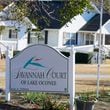Atlanta office space by the numbers
Overall vacancy rate: 17.8 percent
Average rent: $21.73 per square foot
Average rent Class A: $24.14 per square foot
Major submarket vacancy rates: Downtown (22 percent), Midtown (16.2 percent), Buckhead (14.1 percent), Cumberland (19.2 percent) Central Perimeter (15.8 percent).
When medical products maker Bauerfeind went searching for a new U.S. headquarters location in metro Atlanta, the German company found the office space it wanted: the Promenade skyscraper in Midtown with a direct MARTA link to the airport.
But the seven-month search wasn’t easy. Space in many trophy office buildings was tight and there wasn’t much flexibility to negotiate with owners. If Bauerfeind’s 30-person office had needed much more than about twice the space as a large suburban home, the search might have taken even longer.
“When we began the process, the market was getting tight,” said Greg Vaughn, CEO of Bauerfeind USA. “It’s only gotten even tighter.”
Available space in Atlanta area office buildings has dropped to the lowest amount in more than a decade amid steady post-recession job growth, while few new buildings are coming out of the ground. That combination pushed rents in Atlanta to an all-time high in the quarter ended in September, according to CBRE Research.
In a metro area historically prone to over-development, an argument could be made that Atlanta is experiencing under-development of high-grade office space.
“I don’t know that we’ve ever had so much demand on the tenant side with so little construction,” said Steve Dils, Atlanta managing director of sales and leasing for brokerage Avison Young.
Only one “speculative” office skyscraper, or one without a user already in mind, is currently under construction in Atlanta. That building, Three Alliance Center in Buckhead, would be the first new spec skyscraper since the recession. Other office projects are on the drawing board, but it is uncertain when construction might start and they are likely to be a few years away from opening.
It took brokers years to lease up the glut of empty space left by corporate downsizing and the rush of new development during the last cycle.
Dan Wagner, CBRE’s Southeast regional research manager, said growth in technology jobs and services industries continue to be a boon for Atlanta.
The vacancy rate throughout the metro area was 17.8 percent at the end of third quarter, according to CBRE Research, with hot areas such as Buckhead (14.1 percent), and Central Perimeter (15.8 percent) and Midtown (16.2 percent) seeing vacancy rates several points below Atlanta norms.
Rental rates overall hit a record high of $21.73 per square foot across all classes of buildings in the third quarter, although they remain well below those of other cities like Washington, D.C., Boston, New York or Chicago, meaning the Atlanta region is still a steal by comparison.
And rents in the top-tier buildings – also at an Atlanta high of $24.14 per square foot — aren’t yet so high that it makes sense for many new towers to rise, experts said.
Building to order
Plenty of office construction is happening for corporate campuses owned or otherwise controlled by the main tenant, such as State Farm and Atlanta Journal-Constitution-parent Cox Enterprises near Perimeter Mall and NCR in Midtown. But compared to past economic cycles, little speculative office construction is underway.
Several developers have speculative office sites identified and have completed the zoning process for projects in areas including Midtown, Buckhead, the areas around Perimeter and Cumberland malls and the Avalon development in Alpharetta.
For the past several quarters, the traditionally strong Central Perimeter area near Perimeter Mall, Buckhead, Midtown and the North Fulton submarkets have been winners of the most space taken or absorbed by tenants.
But with costs climbing in those submarkets, tenants are starting to look at the Cumberland Mall area and other less expensive areas.
In the third quarter, the Cumberland-Galleria submarket near Cumberland Mall reported the highest rate of office “absorption,” according to CBRE.
Wagner said that’s in part because of “spillover” from other tightening submarkets.
Cumberland and downtown Atlanta have some of the largest available blocks of space, and cheaper rents. But Cumberland also has new transportation projects that are being built, such as the managed toll lanes along I-75 and I-575.
The area’s popularity might also have something to do with what Cobb boosters have called a halo effect from the new Braves stadium.
Two speculative projects are ramping up near the stadium site – Riverwood 200 and an office building that Columbus-based Synovus Financial will anchor southeast of the I-75/I-285 interchange.
The Battery
The Braves mixed-use development, known as The Battery, wooed Comcast for a technology center where it will plant about 1,000 workers.
“I thought there might be a pause for some companies waiting it out to see how (the Braves project) comes together,” Wagner said. “I think there will be some challenges in that area, but also some successes.”
Wagner said Midtown continues to be hot with tech-focused companies and firms looking to open innovation labs.
Bauerfeind, the German company that makes compression stockings for medical and sports use, as well as orthopedic products, decided to shift its offices earlier this year.
The U.S. arm had operated mostly as a distribution center for its German parent at a warehouse and office location near Kennesaw. But Vaughn said the company wanted to grow into a full U.S. headquarters operation that could lead to research and development functions and potentially manufacturing.
Bauerfeind scouted sites in the Cumberland area and Midtown. Ultimately, a rail connection to Hartsfield-Jackson International Airport and the talent pool helped convince the company to pick the Midtown’s Promenade tower near the Woodruff Arts Center, Vaughn said.
About the Author






